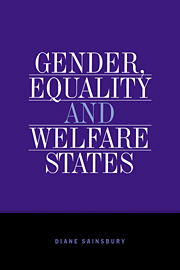Book contents
- Frontmatter
- Contents
- List of figures
- List of tables
- Acknowledgments
- Introduction
- Part I Dimensions of variation
- Part II Bases of entitlement
- Part III Stratification and redistributive outcomes
- 6 Access to benefits and the stratifying effects of bases of entitlement
- 7 Benefit inequalities and redistributive outcomes
- Part IV Welfare state restructuring
- Notes
- References
- Index
6 - Access to benefits and the stratifying effects of bases of entitlement
Published online by Cambridge University Press: 18 September 2009
- Frontmatter
- Contents
- List of figures
- List of tables
- Acknowledgments
- Introduction
- Part I Dimensions of variation
- Part II Bases of entitlement
- Part III Stratification and redistributive outcomes
- 6 Access to benefits and the stratifying effects of bases of entitlement
- 7 Benefit inequalities and redistributive outcomes
- Part IV Welfare state restructuring
- Notes
- References
- Index
Summary
Social entitlements stratify categories of persons by either granting or denying access to benefits. Keenly aware of differences in women's and men's social entitlements, feminists have argued that a gendered pattern of stratification pervades social provision. Women and men are channeled into separate programs, resulting in a system of dual welfare. Men's maintenance by the state is through social insurance schemes based on claims as earners, while women make their claims on the basis of domestic work and rely more heavily on public assistance programs (Nelson 1984,1990, Pearce 1985: 457–9, Pateman 1988: 241–2, Fraser 1989: 152, Bryson 1992). Social insurance and assistance programs are further differentiated in terms of benefit levels, political legitimacy, and administrative intervention in private lives. The benefits of social insurance schemes are usually more generous, while assistance benefits, perhaps reflecting their lineage from poor laws, are often meager. Social insurance programs enjoy widespread popular support and legitimacy as “earned rights.” By contrast, assistance programs frequently are viewed negatively and their recipients with suspicion. Standard routines with little or no intervention in one's private life characterize the administration of social insurance, but assistance is means-tested involving a detailed investigation of an individual's resources and the resources of relatives. In effect, feminists have theorized that dual welfare and its far-reaching implications for women and men as beneficiaries are intrinsic to social provision and the welfare state.
In mainstream analysis the work of Esping-Andersen has emphasized the welfare state as a system of stratification, but his regime typology underlines stratification as a welfare state variation (1990: chapter 3). Each regime type is associated with a dominant pattern of stratification.
- Type
- Chapter
- Information
- Gender, Equality and Welfare States , pp. 129 - 147Publisher: Cambridge University PressPrint publication year: 1996
- 1
- Cited by



